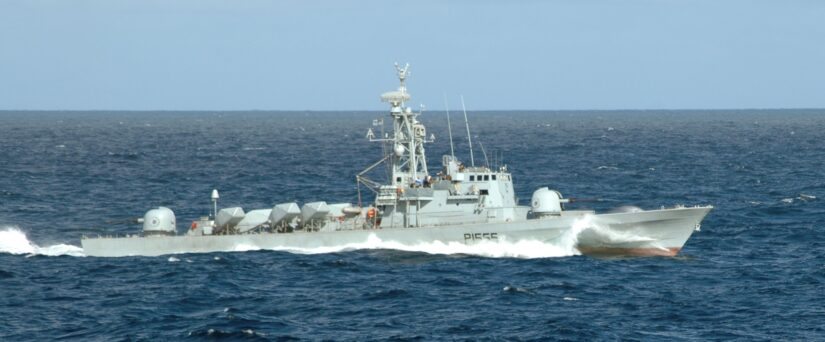HIGHLIGHTS OF A LONG CAREER
Commander Leon Steyn, Historian, SA Naval Museum
On 21 April 2022 the offshore patrol vessel SAS Isaac Dyobha entered Simon’s Town for the last time, to be decommissioned after nearly 43 years of service.
INTRODUCTION
P1565 was one of six Minister class strike craft that were built for the South African Navy under the Project Japonica designation. The first three boats were constructed in Haifa, Israel, but the next three – P1564, P1565 and P1566 – were built locally in Durban by Sandock Austral. This was a major achievement for the local shipbuilding industry at the time. Three more improved boats (P1567, P1568 and P1569) were built under the Project Coupe designation to bring the number of strike craft in service to a total of nine.
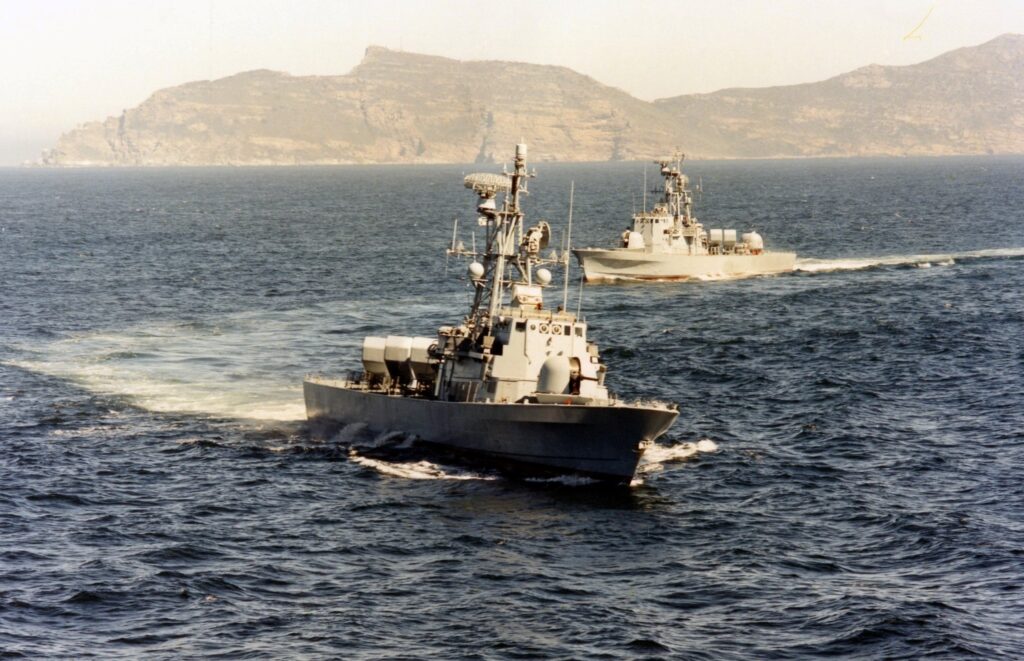
P1576 was launched at Sandock Austral on 16 March 1979 and commissioned in to naval service on 27 July 1979 and named SAS FRANS ERASMUS, after a former Minister of Defence (1948-1959). The important lessons learned in the construction of boats four and five were soon incorporated into the subsequent building of boats five and six. It was a steep learning curve for, not just the shipbuilding industry, but also for the navy who were in the process to transition from the traditional “blue-water navy” (the era of frigates and destroyers) to a smaller but more efficient coastal “brown-water” navy at that time. With the addition the additional vessels, a strike craft flotilla was formed in 1977 and its headquarters unit SAS SCORPION in 1980, situated on Salisbury Island in Durban.
DAVID VS GOLIATH
The new strike craft was soon flung into action under the command of Cdr M.A. Rennie and together with P1561 (later named SAS JAN SMUTS) responsible for an infamous incident that made front page headlines. On 14 January 1980 the two strike craft intercepted a US Navy task force that rounded the Cape and consisted of the huge nuclear-powered aircraft carrier, USS NIMITZ and the nuclear-powered cruisers USS CALIFORNIA and TEXAS. The United States later alleged that the strike craft had manoeuvred in the close vicinity of one of its cruisers and that the SA Navy had harassed the powerful naval battle group. In an official reply the SA Navy stated that ‘it had no intention to harass ships of any nation, but that it would exercise its right to monitor at close quarters the vessels of any other navy passing along the South African coast.’
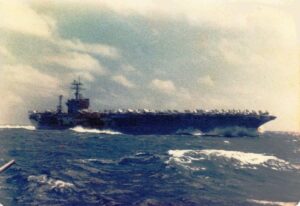
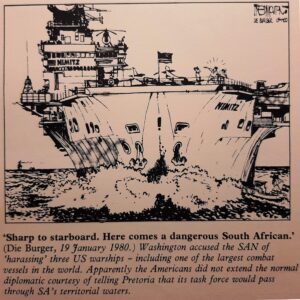
Boat five again crossed paths with an American aircraft carrier 28 years later, thankfully under more cordial circumstances. In October 2008, the US aircraft carrier, THEODORE ROOSEVELT visited South African and together with the cruiser USS MONTEREY and French frigate FLOREAL took part in exercises along the coast of Kwazulu-Natal with the SA Navy’s SAS DRAKENSBERG, CHARLOTTE MAXEKE, ISANDLWANA and ISAAC DYOBHA.
COVERT OPS
During the so-called Border War the SA Navy played a relatively small role relative to the Army and Air Force, but nevertheless provided support. Strike craft and submarines were imminently suitable to land special forces operators and did so in no less than 31 covert deployments on the Mozambican coast and 21 on the Angolan coast. From the 52 deployments, nine were conducted by SAS FRANS ERASMUS between 1980 and 1984.
TO CHILE
The South African government’s persistent policy of apartheid resulted in world-wide condemnation, weapons boycotts and increased isolation. This affected the navy negatively for most of the 1970s and 1980s and prevented any international flag showing cruises. In March 1988 however the SAS DRAKENSBERG and SAS FRANS ERASMUS crossed the South Atlantic and rounded the notorious Cape Horn for a month long visit to Chile. This was only the second time ever that a South African naval vessel had rounded the Horn. SAS PROTEA had accomplished this ten years earlier, but SAS DRAKENSBERG and SAS FRANS ERASMUS sailed further north to the port of Valparaiso.
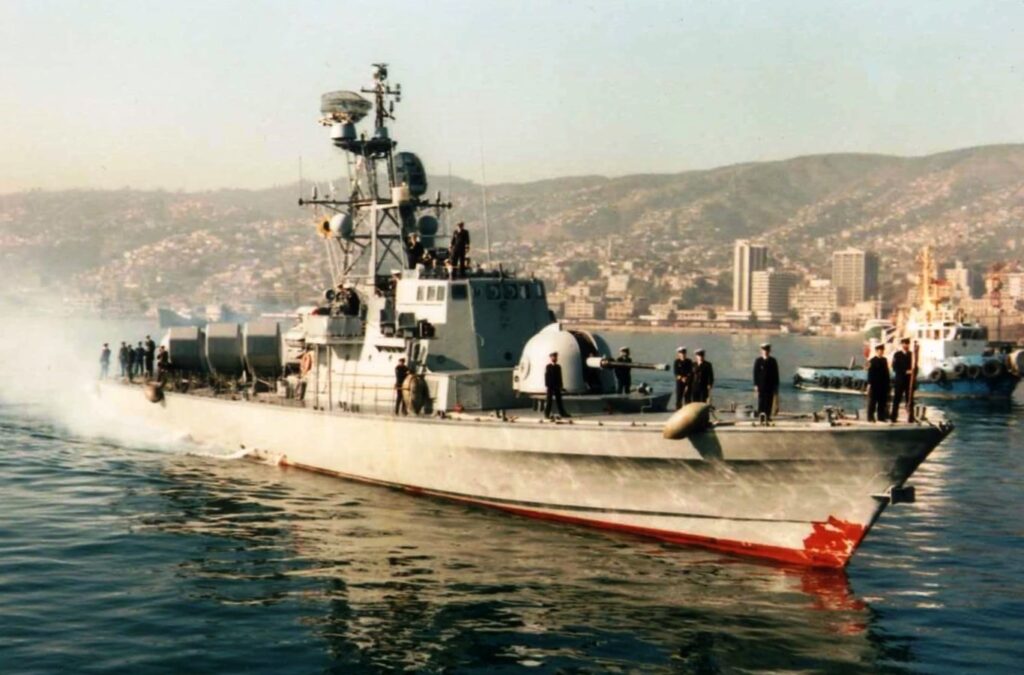
WARNING SHOTS
On 23 June 1990, the strike craft, FRANS ERASMUS intercepted the fishing trawler, PETROUS 1 along the South African east coast, where the trawler was fishing illegally. The master of the trawler initially did not heed the call to sail to East London, but had a change of mind when the strike craft fired a number of warning shots. The FRANS ERASMUS escorted the trawler to East London.
RESCUE OPERATIONS
On 4 August 1991 the cruise ship MTS OCEANOS sank in heavy seas off the coast of Transkei, while en route from East London to Durban. In one of the most dramatic rescue operations ever, SAAF helicopters and Navy divers rescued all 580 passengers and crew. Despite atrocious sea conditions, four Durban-based strike craft, SAS JAN SMUTS, FRANS ERASMUS, JIM FOUCHE and OSWALD PIROW were sent to the scene of disaster to provide assistance.
Another rescue operation occurred many years later on 28 March 2007 when ISAAC DYOBHA was called out to assist the fishing vessel ALMA LUCIE. Just a few months later, in November 2007 the strike craft again came to the rescue of a capsized yacht, the NEW YORK CLIPPER off Durban to save the crew. The prestigious Navy Sword of Peace was awarded to the officer commanding and crew in 2007 for these valiant actions.
RESERVE, REFIT & RENAMING
SAS FRANS ERASMUS decommissioned on 2 July 1993. The vessel spent some time in reserve in Durban before being taken in hand for a refit and modernisation. In line with the post 1994 political changes, the names of the strike craft were changed on 1 April 1997 – in time for Navy 75 celebrations and the Presidential Fleet Review. P1565 was renamed SAS ISAAC DYOBHA in honour of the Xhosa reverend that was on board the SS MENDI when the troopship sank in the English Channel on 21 February 1917. (see below) In 1999 boat five emerged from a major refit with updated electronic systems fitted under Project CALIBAN and recommissioned under the command of Cdr G.F. “Podge” Harrison on 14 April 1999. This was the start to the second half of its service in the Navy – “five was alive again”.
EXERCISES AND OPERATIONS
Apart from the annual “own forces” RED LION exercise, SAS ISAAC DYOBHA were part of almost every other multinational and joint naval exercise held in South African waters since 1999. This included GERANIUM in 2000, ATLASUR V in 2002, GOOD HOPE II in 2006, ATLASUR VII and GOOD HOPE III in 2008, OXIDE 2 in 2013 and OXIDE 3 in 2015. Operation KGWELE was a particularly important safety and security operation for the Soccer World Cup that was hosted in South Africa from 11 June to 11 July 2010. SAS ISAAC DYOBHA and GALESHEWE comprised the seaward defence element at the various coastal cities where world cup games were hosted.
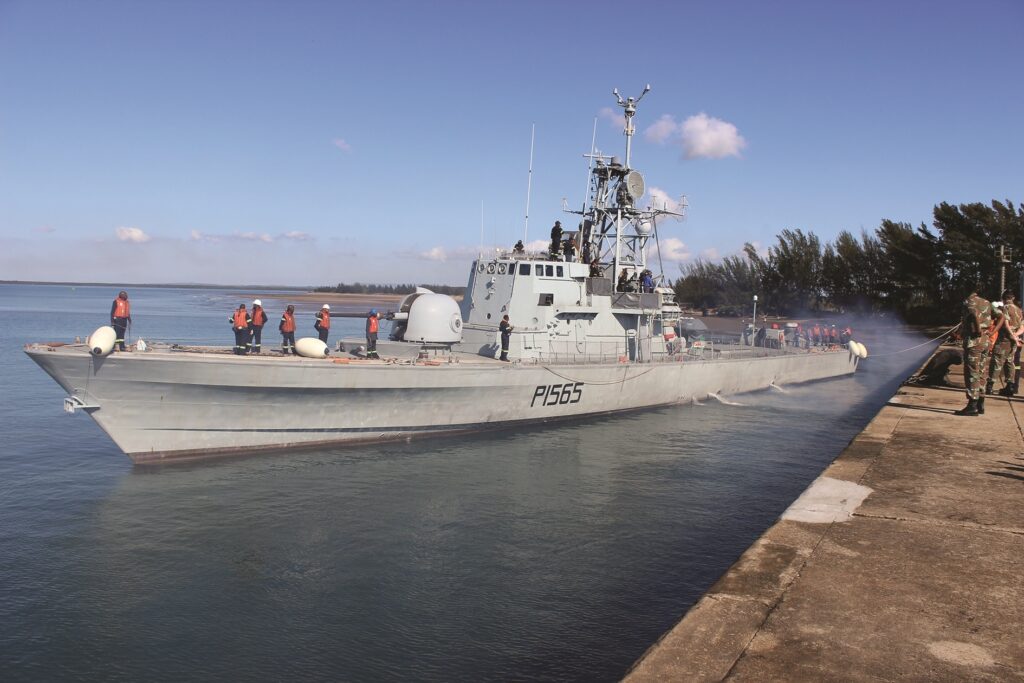
An anti-piracy operation in the Mozambique Channel – Operation COPPER – was initiated in 2011. The operation initially only saw the rotational deployment of the four Valour class frigates and SAS DRAKENSBERG. The three refurbished OPV’s operating from Durban, however offered a more economical alternative and from 2014 SAS ISAAC DYOBHA together with GALSESHEWE and MAKHANDA were all regularly deployed in this operation on a rotational basis. Their presence in the area was furthermore required as recently as 2022 when an upsurge in insurgency activities in Mozambique’s Cabo Delgado province required SADC intervention. The Navy deployed SAS ISAAC DYOBHA and MAKHANDA in support of this operation.
CHANGING OF THE GUARD
P1565 was present to both see the end of the President class frigate era and the birth of the new Valour class frigate era. On 29 April 1991 SAS FRANS ERASMUS was one of five strike craft that participated in a live firing exercise to sink the decommissioned President class frigate SAS PRESIDENT STEYN with missiles and 76mm cannon.
Boat five was also present on 4 November 2003 when the first new Valour class frigate, SAS AMATOLA (under command of Capt D.G. Jamieson – himself a former SC OC) arrived in False Bay from Germany. AMATOLA entered Simon’s Town to a joyous welcome in the company of SAS DRAKENSBERG, escorted by three strike craft, SAS ADAM KOK, GALESHEWE and ISAAC DYOBHA.
The introduction of the new Valour class frigates (fitted with Exocet SSM) signalled the end of the obsolete Skerpioen SSM system which was phased out of service and removed from the boats towards the end of 2007. The removal of the missile boxes and later, the rear 76mm cannon provided space for a small RHIB and MRS boarding party. Subsequently, from 2012 to 2014, three of the four remaining Warrior class strike craft were refurbished by SA Shipyards in Durban and re-designated as offshore patrol vessels (OPVs). SAS ISAAC DYOBHA together with SAS GALESHEWE and MAKHANDA were home ported at the re-established Naval Base Durban to form the new Patrol Squadron, while SAS ADAM KOK (P1563) remained in reserve.
PRESIDENTIAL FLEET REVIEWS
Through the years P1565 participated in various harbour festivals, open days and three of the four presidential fleet reviews that have been held. These were on 3 February 1988 in Mossel Bay during the Dias Festival, 3 April 1992 in Table Bay on the occasion of the Navy’s 70th anniversary and 5 September 2008 in Simon’s Town to present the “modern fleet” to the Commander-in-Chief, then President Thabo Mbeki and the nation.
2nd OLDEST VESSEL IN SERVICE
Should SAS ISAAC DYOBHA remain in commission until 23 July, the vessel will tie the second place as the second oldest SA naval vessel in commission. The boom defence vessel SAS SOMERSET (1943-1986) and the minesweeper SAS EAST LONDON (1958-2001) also reached 43 years in service. SAS PROTEA remains the oldest vessel in service and celebrated 50 years in service on 23 May 2022.
The strike craft have exceeded their intended design life – a credit to their durability. The vessels were originally designed for the calmer Mediterranean Sea and not ideally suited to the South African sea conditions. The last three boats that remained in service continued on admirably in their new role as offshore patrol vessels between 2012 and 2022 and are now progressively phased out as the new (Project BIRO) Warrior class inshore patrol vessels are introduced into service. Credit must go to the men and women of the South African Navy who operated and maintained these proud vessels so successfully and professionally for more than four decades.
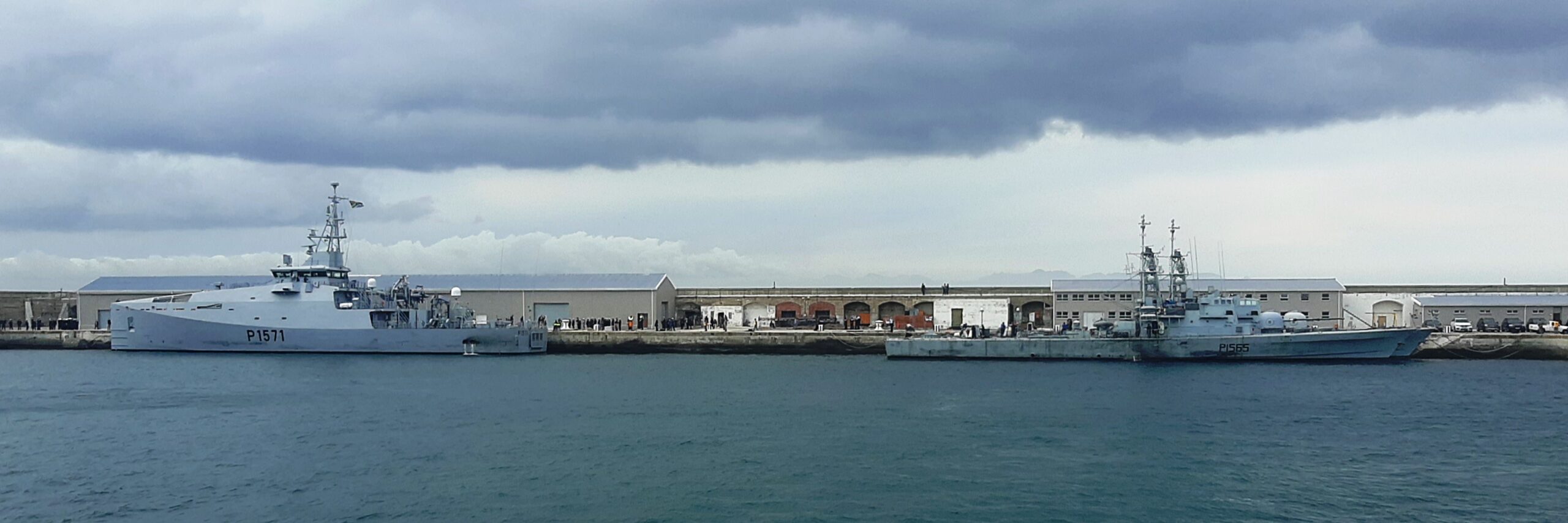
P1565 – LIST OF COMMANDING OFFICERS: 1979-2022
SAS FRANS ERASMUS
| Cdr M.A. Rennie | 22/7/1979- 20/2/1981 |
| Cdr H.V.E. Bester | 20/2/1981- 5/11/1982 |
| Cdr B.R. Donkin | 16/5/1983- 23/9/1985 |
| Cdr F.E. Koetje | 23/9/1985- 26/2/1986 |
| Cdr A. van der Westhuysen | 12/3/1992-11/12/1992 |
| Cdr S.J. Artman | 11/12/1992- 2/7/1993 |
Decommissioned 1993, in reserve 1993-1997,
renamed 1997, refitted 1998-1999
SAS ISAAC DYOBHA
| Cdr G.F. Harrison | 14/4/1999-1/6/2001 |
| Cdr M.A. Boucher | 1/6/ 2001-12/12/2003 |
| Cdr J.M.V.E. Beyleveld | 12/12/2003-1/9/2006 |
| Cdr G. Wessels | 1/9/2006-12/2007 |
| Cdr J.M. Mbotho | 7/12/2007- 4/2009 |
| Cdr M.M. Clulee | 4/2009 – 5/2013 |
| Cdr D. Jones | 7/5/2013-31/7/2015 |
| Cdr N.K. Mabuse | 31/7/2015-10/4/2019 |
| Cdr P.J. Jacobs | 10/4/2019- present |
SOURCES:
A. du Toit, South Africa’s Fighting Ships: Past and Present, (Rivonia: Ashanti, 1992)
D. Steyn and A. Soderlund, Iron Fist from the sea: South Africa’s Seaborne Raiders 1978-1988, (Solihul: Heleon, 2015)
L. Steyn, The South African Navy: 25 Years of Democracy, (Simon’s Town: SA Navy, 2019)
A. Wessels, A Century of South African Naval History (Gansbaai: Naledi, 2022)
South African Naval Museum Archives (File: P1565, SAS Frans Erasmus/Isaac Dyobha)
